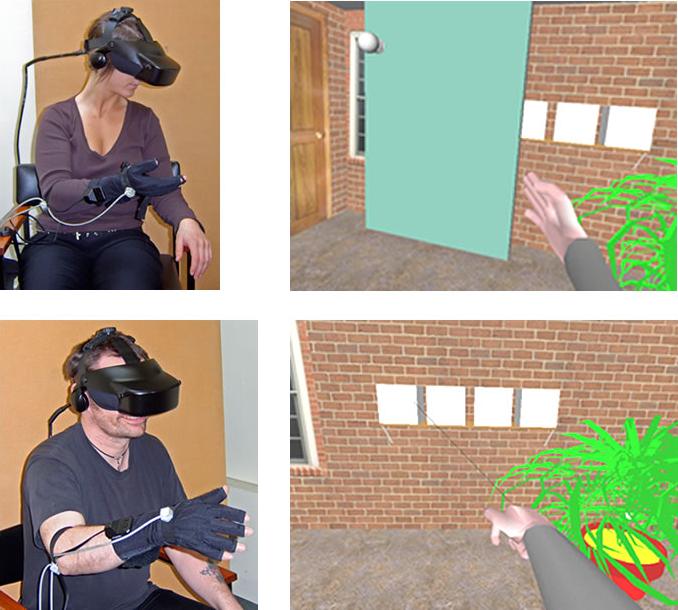A research collaboration between the Advanced Interfaces Group, School of Computer Science, and the School of Psychological Sciences. University of Manchester, United Kingdom. This research is funded by the Bial Foundation.
Investigators: Craig Murray (PI, Psychology), Toby Howard and Steve Pettifer (Computer Science)
Researchers: Fabrice Caillette, David Wilde, Emma Patchik, Jezz Fox, Christine Simmonds
Press release (17 July 2006): "Virtual reality puts telepathy to the test" [ html ] [ PDF ]
Video: Here's a short video (4Mb) about the system (requires Windows Media Player).
Pictures: Some images of the system in use.
Publications:
- Craig Murray, Toby Howard, Jezz Fox, Fabrice Caillette, Christine Simmonds-Moore, David Wilde, The design and implementation of the telepathic immersive virtual reality system, Parapsychological Association Convention 2006. Stockholm, Sweden. August 4-6 [ PDF ].

This project is a collaboration between Psychology (School of Psychological Sciences) and the Advanced Interfaces Group (School of Computer Science) at the University of Manchester, and Psychology (Deanery of Sciences and Social Sciences) at Liverpool Hope University.
This study involves the use of Immersive Virtual Reality (IVR) in the study of telepathy, or the communication of information between two people without the use of the known senses. Virtual reality (VR) denotes the use of three-dimensional computer graphics technology to generate artificial environments that afford real-time interaction and exploration. These are intended to give the user an impression of being present or immersed in a computer-generated world. Within this study participants will explore a virtual environment using a head-mounted display and glove.
Participants will take part in pairs in which they will act as a Sender (S) or Receiver (R). During the study the S and R will be located in different rooms in the Psychology department. Each of these rooms will have identical IVR set-ups, including the same virtual environment. The networked computers providing the virtual environment for S and R essentially provide two identical environments which are explored simultaneously by S and R, but without any visual (and in the case of R, auditory) awareness of each another. S and R will be immersed in identical virtual environments at the same time. R will be able to see and interact with four different objects, but S will only be able to do this for one of the objects.
During the experiment S will be asked to try and convey the target object to R verbally, imaginably and through interaction with the object. R will be asked to try and receive the target object, by interacting with the target pool objects and speaking aloud. Following completion of the trial R will be required to choose which of the four objects the target was and to rate the likelihood of it being each of the four objects. This is the participant information sheet.
|
21 July 06: The telepathy study is now complete, and we're not currently recruiting participants. |
Contacts
- David Wilde, (Psychological Sciences): David.J.Wilde@manchester.ac.uk : (+44) 161 275 2552
- Toby Howard (School of Computer Science): Toby.Howard@manchester.ac.uk : (+44) 161 275 6274
Press coverage
- Times Newspaper, 06 Septermber 2006
- Google news index
- Times Higher Education Supplement, 3 August 2006
- Physorg.com: "Virtual reality puts telepathy to the test"
- BBC Radio Leeds interview
- Russell Jenkins: "Is it the meat cleaver or the trumpet?"
- First Science.com: "Virtual telepathy"
- BBC News Manchester: "Are you telepathic?"
- ABC News: "Researchers look for signs of telepathy"
- Japanese translation of BBC item: 「バーチャル世界でのテレパシー・テスト」
- Web India 123: "British scientists test for telepathy"
- Slashdot backslash commentary
- China People's Daily: "UK scientists create virtual computer world to test telepathy"
- Sydney Morning Herald: "Test for telepathic talent"
- CNET news: "Virtual world tests telepathy"
- BBC Online News: "Virtual worlds to test telepathy"
- BBC Focus: "Telepathy put to the test"
- The Guardian: "Scientists seek virtual telepathy"
- IET News: "Manchester Uni launches most objective telepathy tester"
- Slashdot: "Virtual reality gaming system tests for telepathy"
- Scienceblog: "Virtual reality gaming system tests for telepathy"
- Physorg.com: "Virtual reality puts telepathy to the test"
- Eurekalert: "Virtual reality puts telepathy to the test"
- Manchester Evening News: "Computer game tests for telepathy"
- Manchester Metro: "Computer game tests for telepathy"
- BBC Manchester Radio interview with Terry Christian
- Key103 Manchester Radio
- Science News Daily: "Virtual reality puts telepathy to the test"
- Science Daily: "Virtual reality puts telepathy to the test"
|
Related work: A previous collaboration between the School of Psychological Sciences and the School of Computer Science investigated the use of immersive VR technology as a rehabilitative experience for amputees who experience phantom limb pain. |